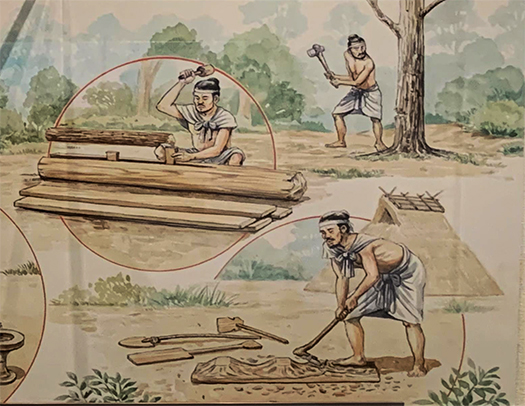


人間生存の基本は水。
この飛鳥の都でも多くの人が参集・住居するのにまずは水道施設がキモ。
山岳地形の日本での人類生存、文化発展を考えたら
目に見える河川と同時に豊富な地下伏流水利用も活発だっただろう。
山岳には豊かな保水機能があり、それが多様な伏流水を形成する。
この列島に石器時代に暮らし始めた人類にとって
湧き水の発見とか、水の脈絡を探究し利用する知識は
想像をはるかに超える知的蓄積だったに違いないと思っています。
飛鳥の都地域でも地下伏流水と河川水の両方を利用して
「苑池」を土木工事する技術はすばらしい痕跡を見せている。
近現代では確立された水道知識が常識化し人類本来の水の知恵への気付きが
減衰している現代人は、きっと想像力も鈍磨しているのでしょう。
とくにこの飛鳥京の段階まで来ると「都市建設」という
権力が必要とする人工的な集住環境構築が求められるようになる。
水田耕作という弥生以来の生産様式は必然的に水資源管理が不可欠。
この生産様式の出自は東アジア、揚子江流域地域に淵源を求める説が
優勢とされていますが、それがこの日本列島に伝播してきたとき、
独特の大発展を見せたに違いないと想像しております。
というのは、この火山列島では山岳の保水力がハンパなく
土木工事で水脈をコントロールする技術が急発展したと思えるのです。
日本の土木技術はその後の国内戦争での発展ぶりを見ればあきらか。
武田信玄の「穴掘り衆」秀吉段階の土木工事による戦争などが象徴的。
この飛鳥京の考古発掘を展示している橿原考古博物館でも
まさに正鵠を穿つようにこうした「水」管理の状況展示が示されている。
山岳地形の国土でかつ降雨の多い気候条件下では優良な木質資源が得られる。
更新生命力も非常に高いことから「木を扱う」技術も発展した。
日本の住宅が木造が伝統的に優勢で住文化の基本になっていることも
こういった背景条件からと言えるのでしょう。
上の写真では地下伏流水を組み上げる井戸に使われた大口径木材と
それがみごとに「くり抜かれて」利用されていた様子がわかる。
列島各地で分散的に水田・ムラ開発されていた段階から、この飛鳥京では
都城建設という新段階にまで社会が進化発展してきた。

上の写真は樋菅という導水装置で大木が利用されている。
水源管理のための計画的土木建設作業がより大規模に展開した。
水道としては石材加工と平行的に大径木も大いに利用された、というか、
どちらかといえば木工事部分の方が多用されていたに違いない。
この飛鳥京の段階から次の法隆寺、平城京段階になるとさらに都城の規模は
旺盛に拡大発展していくことになる。
奈良の都建設段階では仏教寺院の建設ラッシュなどで
周辺の山岳自然林の利用許容限界にまで至ったと想像されている。
水の管理って、歴史を動かす「底流」のようなものと感じられます。
English version⬇
Asuka-kyo Waterworks “Gutters and Wells” Exploration of Asuka, Nara – 5
The Japanese archipelago, with its humid temperate climate and mountainous terrain, also has highly renewable wood resources. Paddy field development developed water vein exploration and civil engineering techniques. ・・・・.
Water is fundamental to human survival.
Even in the Asuka capital, water supply facilities are the key for many people to gather and live in.
In Japan, with its mountainous terrain, the survival of mankind and the development of culture are of paramount importance.
The use of visible rivers as well as abundant underground subterranean water would have been active.
Mountains have a rich water retention function, which forms a variety of subterranean waters.
For humans who began living in this archipelago in the Stone Age
The discovery of spring water and the knowledge to explore and use water veins
I believe it must have been an intellectual accumulation far beyond imagination.
Even in the Asuka capital area, both underground subsoil water and river water were used
The technique of civil engineering the “garden pond” shows wonderful traces.
In modern times, the established knowledge of water supply has become common knowledge, and people’s awareness of the original wisdom of water
Modern people, whose imaginations have been waning, must have dulled as well.
Especially when it comes to the Asuka-kyo stage, the “city construction
The construction of an artificial living environment required by the power of the people is required.
Water resource management is essential for paddy field cultivation, a production method that has been practiced since the Yayoi period.
The origin of this mode of production is believed to have originated in East Asia, in the Yangtze River basin region.
When it spread to the Japanese archipelago, it is said to be the predominant
I imagine that this must have been a unique and significant development.
This is because the water retention capacity of the mountains in this volcanic archipelago is so great that it is difficult for the mountains to retain water.
It seems to me that the technology to control water veins through civil engineering work developed rapidly.
The development of Japanese civil engineering technology is evident in the subsequent domestic wars.
The “hole diggers” of Shingen Takeda and the wars caused by civil engineering works during the Hideyoshi stage are symbolic.
The Archaeological Museum of Kashihara, which exhibits the archaeological excavation of the Asuka-kyo Palace, is also a good example of the development of civil engineering technology.
This is exactly the kind of “water” management situation that hits the nail on the head.
The mountainous terrain and rainy climatic conditions provide excellent woody resources.
The renewal vitality is also very high, which has led to the development of “tree-handling” techniques.
The fact that wood construction has traditionally been the predominant type of housing in Japan and has become the basis of Japanese housing culture
This is the reason for the background conditions.
In the photo above, you can see the large-diameter timbers used for the wells that bring up underground subterranean water, and
The way it was “hollowed out” and utilized can be seen.
The Asuka-kyo capital was developed from the stage of dispersed development of rice paddies and mura (rice fields) in various parts of the archipelago.
Society has evolved and developed to a new stage of capital city construction.
The photo above shows a water conduit called a flume, which utilizes large trees.
Planned civil construction work for water source management developed on a larger scale.
Large-diameter trees were also used in the water supply system in parallel with stone work, or rather
If anything, the woodwork portion must have been used more extensively.
From the Asuka-kyo stage to the Horyu-ji and Heijo-kyo stages, the scale of the capital city increased even more.
The development of the city was vigorously expanded and developed.
During the construction phase of the Nara capital, the rush to build Buddhist temples and other structures
It is imagined that the use of the surrounding natural mountain forests reached its limits of tolerance.
Water management is felt to be a kind of “undercurrent” that drives history.
Posted on 4月 20th, 2022 by 三木 奎吾
Filed under: 住宅マーケティング, 日本社会・文化研究, 歴史探訪







コメントを投稿
「※誹謗中傷や、悪意のある書き込み、営利目的などのコメントを防ぐために、投稿された全てのコメントは一時的に保留されますのでご了承ください。」
You must be logged in to post a comment.